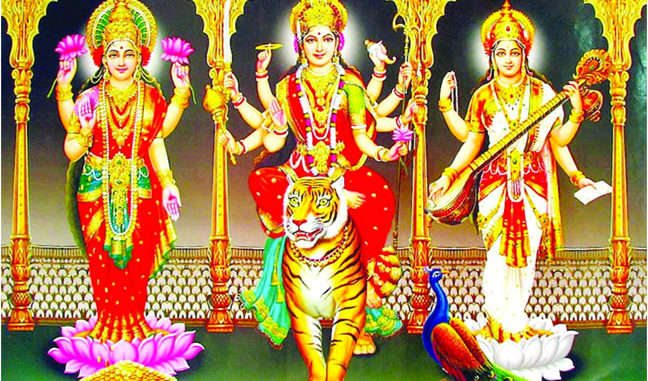
Tridevi, or three goddesses, is a term used in Hinduism to describe the three main female deities. These are Saraswati (who is linked to Brahma), Lakshmi (who is linked to Vishnu) and Parvati (who is linked to Shiva).
Mahalakshmi – The Goddess of Wealth
Sri Mahalakshmi or Lakshmi, as the Goddess is also referred to, is the Hindu Goddess of Wealth, auspiciousness, purity, prosperity and generosity. She also embodies charm, beauty and grace. Lakshmi is a very popular and powerful Goddess in Indian mythology. In fact, representations of Lakshmi, or Shri, are found also in Buddhist and Jain monuments. The earliest archeological representations of Devi Shri were found in Buddhist monuments.
The name “Lakshmi” is derived from the Sanskrit elemental form “lakS,” meaning to observe or perceive. This is also synonymous with “lakSya,” meaning aim, goal or objective. Lakshmi is thus a Goddess who is regarded as the means to achieving several goals, importantly, becoming prosperous.
Lakshmi, the Consort of Sri Maha Vishnu, also incarnates as Sita (during Vishnu’s avatar as Rama) and Rukmini and Radha (during Vishnu’s manifestation as Krishna). As Lakshmi, She is often depicted as an indescribably beautiful woman, seated on a full-bloomed lotus, holding lotus buds in two of her hands, a pot of gold in the third and benignly blessing all those who come to her for succour. She is flanked by elephants, which symbolizes her royal status. Lakshmi, being the Goddess of Wealth, is also depicted as dressed in rich red silk, fully ornamented from head to toe in gold and precious stones.
Lakshmi’s four hands represent four spiritual virtues. The fully bloomed lotus she is seated on, represents the seat of Divine Truth. The aura of joy surrounding her depicts mental and spiritual balance. Peace and prosperity always exist around her.
Sri Mahalakshmi is also depicted as being seated on the Adishesha (bed of snakes), along with her Consort, Vishnu. Vishnu lies in the Ananta Shayan (reclining) position and Lakshmi is seen pressing his feet.
Parvati – The Goddess of Power
Parvati devi, in Hindu mythology, is a representation of the ultimate female divinity, the Shakti. In spite of her being a gentle mother goddess, she is known for unleashing her true power and strength in times of crisis. The Shaktas consider her the ultimate Divine Shakti, the embodiment of the total energy in the universe. Parvati, the daughter of Himavan, the king of the Himalayas, is an incarnation of Sati, the first consort of Lord Shiva, and is the mother of Ganesha, the Elephant-Headed Lord and Kartikeya (Muruga or Skanda). The Devi is usually portrayed with two arms, seated on a lion or tiger. Generally benign, this goddess is also known to take on more powerful and fearful aspects such as Kali, Durga, Chandi and the Mahavidyas.
Her other names include Lalita, Gauri, Girija, Girirajaputri and Shailaja. Yet other names include Shyamala (the dark one), Amba, Ambika, Bhairavi, Aparna and Uma. Legend has it that when Shiva teased her about her dark complexion, Parvati took offense and left him to undergo severe penance to acquire Brahma’s boon for a fairer skin color.
Though Parvati does not make an appearance in Vedic literature, the Kena Upanishad talks about Uma-Haimavati, who manifests as Shakti, the feminine energy of the Supreme Brahman. She reveals the knowledge of Brahman to the Vedic trinity of Agni, Vayu, and Indra. The Ramayana and the Mahabharata talk of Parvati as Shiva’s consort. Kalidasa (5th century) and the Puranas (4th through the 13th centuries) relate in detail stories of Sati-Parvati and Shiva with comprehensive details.
Parvati’s earlier incarnation, Sati, self-immolates at her father, Daksha’s, Yagna (sacrificial ritual). Daksha not only refuses to accept Shiva as his son-in-law, but also insults Sati when she goes to visit the Yagna against her husband’s wishes. Shiva is furious when he learns about Sati’s death. Grief-stricken, he loses interest in worldly affairs and undertakes severe penance in the Himalayas. Sati is reborn as Parvati.
Parvati falls for Shiva and wishes to reunite with him. She regularly visits the cave where he sits deep in penance, cleans up the place and offers puja to him everyday. When he does not even open his eyes to glance at her, however, she is terribly saddened and decides to undergo severe penance herself, in order to please him. She sheds her clothes, refuses food and water and proceeds to do penance in the harsh clime of the Himalayas. Shiva is pleased by her devotion to him and agrees to marry her. They move on from there to mount Kailas, Shiva’s abode.
Saraswati – the Goddess of Learning and Knowledge
Saraswati is the Hindu goddess of learning, knowledge, music and the Arts. Saraswati has also been identified with and likened to the Vedic Saraswati River. She is the consort of Brahma, the Hindu god of creation. Thus, with the goddesses Parvati and Lakshmi, she completes the set of the divine Tridevi (the three goddesses, just like the divine Trinity.
According to Hinduism, Saraswati’s offspring are the Vedas. Saraswati is a very popular Indian goddess and is propitiated to attain knowledge and wisdom. Saraswati also prominently features in Mahayana Buddhism, where she initally manifests in the Golden Radiance Sutra of the late 4th or early 5th Century, in a Mahayana Sutra.
Devi Saraswati is often portrayed as a beautiful, white-skinned woman, attired in pure white, seated on a white Nelumbo nucifera lotus. Her vahana or vehicle is the swan, which symbolizes that she is founded in the experience of the Absolute Truth. Thus, she not only has the knowledge but also the experience of the Highest Reality. Saraswati is mostly associated with the color white, which signifies purity of true knowledge. Occasionally, however, she is also associated with the colour yellow, the colour of the flowers of the mustard plant, that bloom at the time of her festival in the spring. Unlike the goddess Lakshmi, Saraswati is not adorned heavily with jewels, gold and heavy silks, but is shown as attired very modestly, maybe symbolizing her preference of knowledge over worldly material pursuits.
Saraswati is generally shown having four arms, which represent the four aspects of human personality in learning: mind, intellect, alertness, and ego. Alternatively, these four arms also represent the 4 vedas, the primary sacred books for Hindus. The vedas, in turn, represent the 3 forms of literature: Poetry – the Rigveda containing hymns and representing poetry; Prose – the Yajurveda containing prose; Music – the Samaveda representing music. Prose is represented by the book in one hand, poetry by the rosary of crystals, music by the veena. The pot of sacred water represents purity in all of these three, or their power to purify human thought.
A white swan is often located next to her feet. The sacred swan, if offered a mixture of milk and water, is said to be able to drink the milk alone. The swan thus symbolizes discrimination between the good and the bad or the eternal and the evanescent. Due to her association with the swan, Goddess Saraswati is also referred to as Hamsa-vahini, which means “she who has a swan as her vehicle”.
Sometimes a peacock is shown beside the goddess. The peacock represents arrogance and pride over its beauty, and by having a peacock as her mount, the Goddess teaches Hindus not to be concerned with external appearance and to be wise regarding the eternal truth.





Be the first to comment